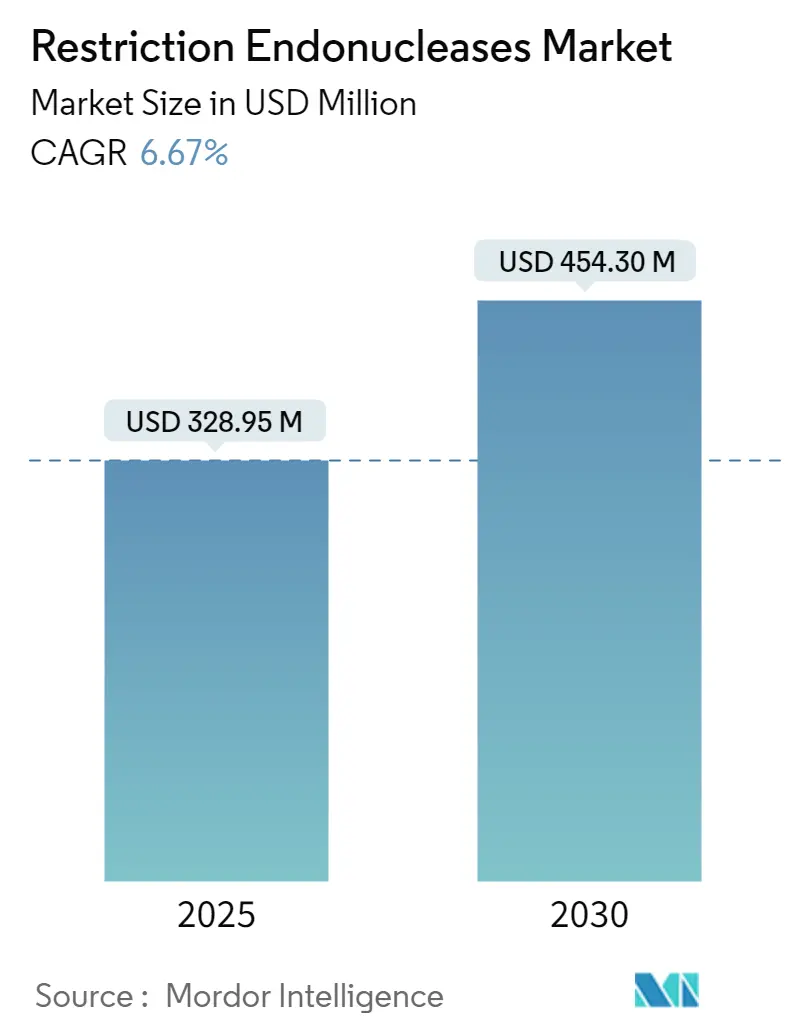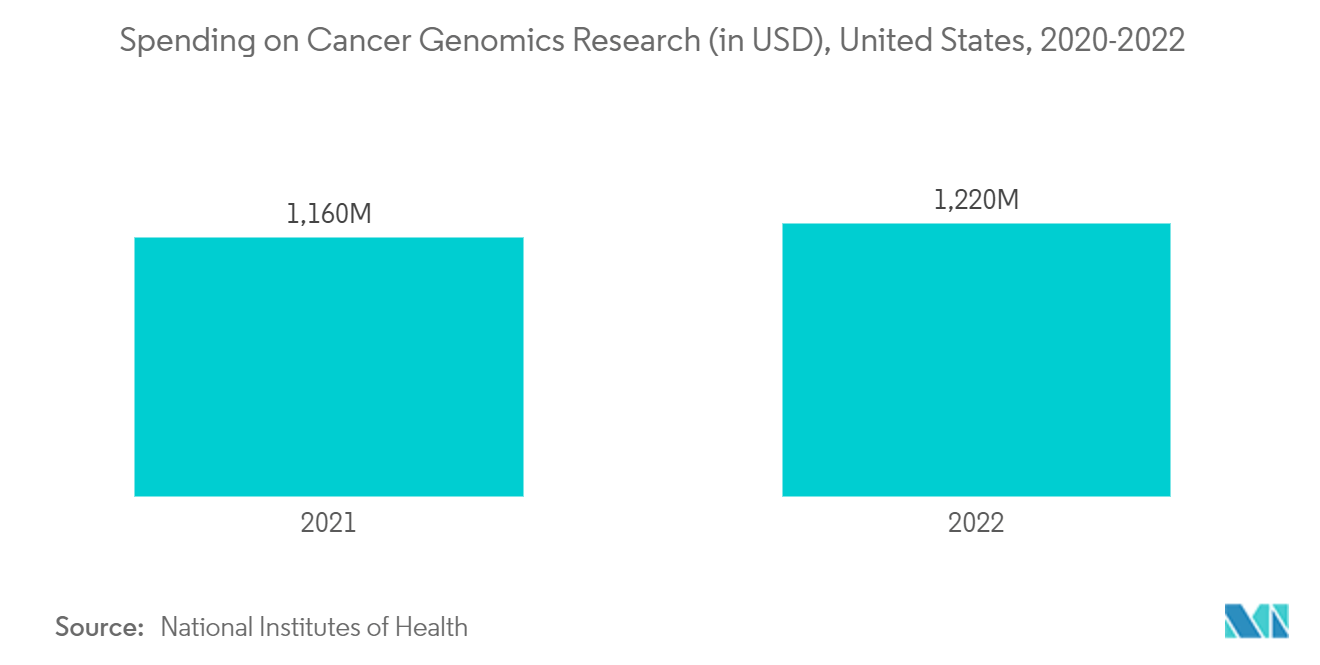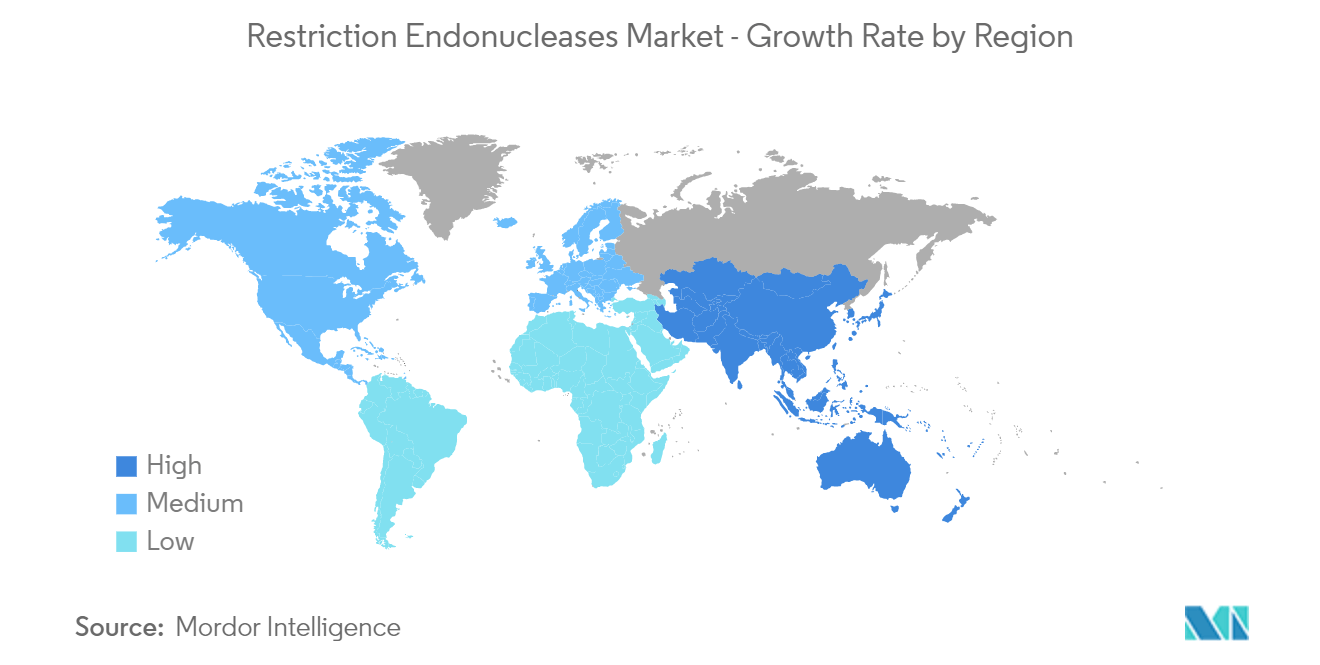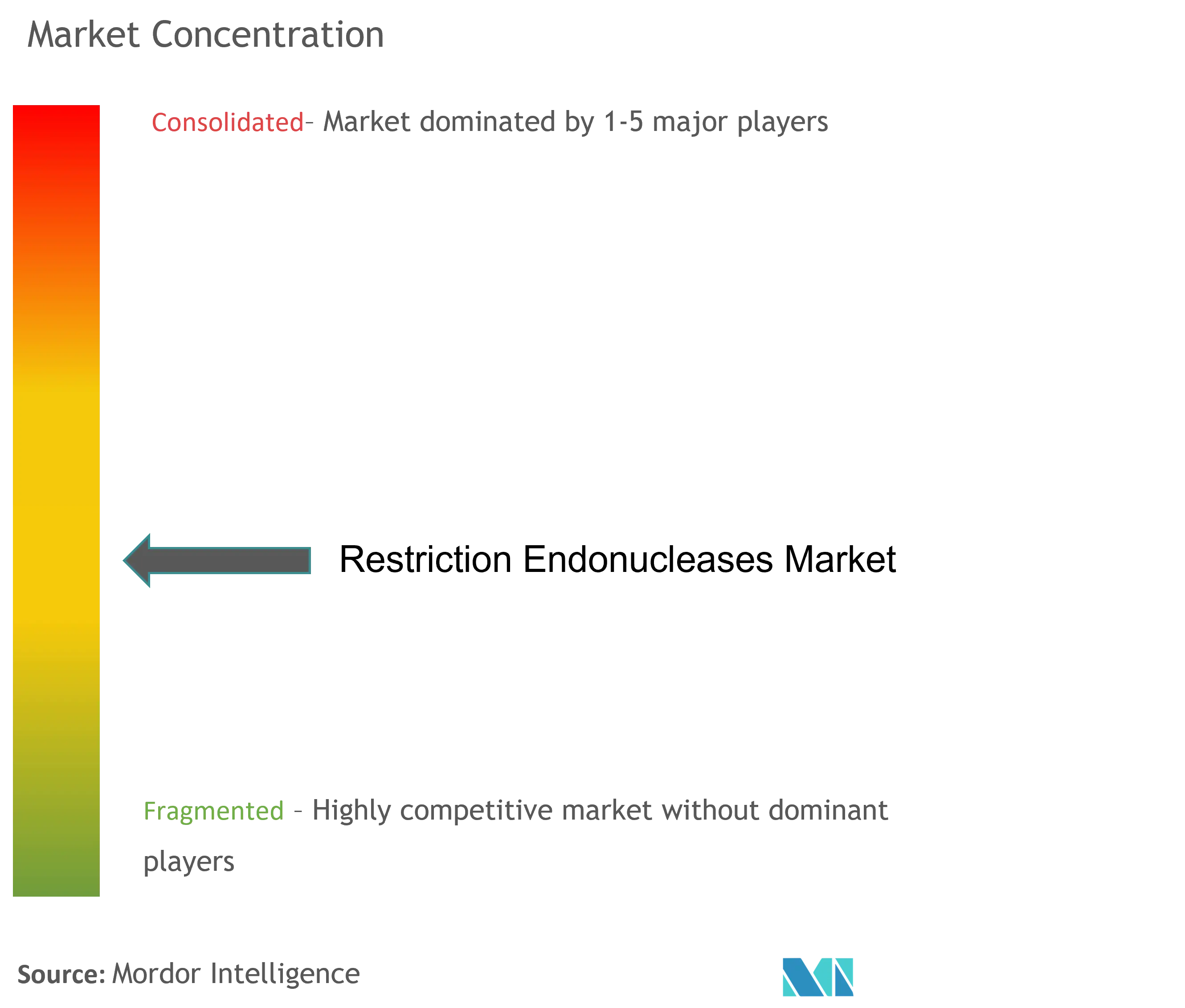
Restriction Endonucleases Market Analysis
The Restriction Endonucleases Market size is estimated at USD 328.95 million in 2025, and is expected to reach USD 454.30 million by 2030, at a CAGR of 6.67% during the forecast period (2025-2030).
The rising use of restriction endonucleases in various applications and increasing expenditure on research and development by biotechnology and pharmaceutical companies are the key drivers for the market.
The rising use of restriction endonucleases in various applications such as genetic engineering and gene sequencing used for research or treatment purposes and increasing expenditure on research and development by biotechnology and pharmaceutical companies are actively affecting the growth of the studied market. For instance, according to the study published by the Institute of Chemical Biology and Fundamental Medicine, Siberian Branch of Russian Academy of Sciences in September 2023, in modern molecular biological practices restriction enzymes are considered as crucial tools, and currently for obtaining DNA fragments, procedures involving restriction enzymes has become a routine task. Thus, increasing use of restriction endonucleases in the reesearch work is expected to propel the market growth over the forecast period.
Furthermore, the increased funding and investment by biotechnology, pharmaceutical companies, and government organizations for research and innovation in the field of genomics is estimated to propel market growth. For instance, according to the National Institutes of Health, National Human Genome Research Institute (NHGRI) 2022 report, the FY 2022 United States President's Budget request is USD 633.0 million, an increase of USD 17.0 million compared with the FY 2021 enacted level. This increase is distributed across all programmatic areas and basic, epidemiology, and clinical research across genomics. To improve human health, NHGRI interacts with a variety of groups, performs and funds genomics research, and educates the next generation of genomics specialists. The huge investment by the NHGRI in the genomics study is expected to utilize a large amount of restriction enzymes during the research, which is expected to propel the market growth during the forecast period.
Also, in September 2022, WhiteLab Genomics raised USD 10 million for an AI-powered genomic therapies platform. The investment is intended to revolutionize the creation of genetic therapies. The company supports its clients to enable them to quickly develop target vectors and payloads and bring genomic-based therapies to market at a faster pace. Hence, the funding and investments are estimated to create opportunities for expansion and innovation in the field of genetic engineering, DNA mapping, and gene sequencing using the restriction endonucleases, which further propels the market growth.
Therefore, owing to the factors such as the utility of restriction endonucleases in various research applications and funding and investment by pharmaceutical and biotechnology companies, the studied market is anticipated to witness growth over the analysis period.
However, the high cost of restriction enzyme production is likely to impede the market growth over the forecast period,
Restriction Endonucleases Market Trends
Genetic Engineering is Expected to Hold a Significant Market Share Over the Forecast Period
The practice of genetic engineering involves changing the DNA sequence in genomes using several methods and molecular biology techniques. The molecular biology tools such as restriction enzymes, DNA sequencing, and DNA cloning which help scientists quickly turn to experiments to change chromosomal DNA in cells and animals.
The factors propelling the segment growth are increasing investments in research and development by biotechnology and pharmaceutical companies to develop various gene therapies for diseases such as cancer, cystic fibrosis, hemophilia, AIDS, and other conditions.
According to the Engineering Biology Leadership Council report published in June 2022, the United Kingdom government has invested strongly in supporting basic research and early translation for transformative products of Engineering Biology (EB). The same source reported that within the next 5 to 10 years, engineering biology has the potential to revolutionize the chemical and material (industrial biotechnology), food and agriculture, and health-related development sectors. By 2030-2040, engineering biology is predicted to unleash an estimated USD 2-4 trillion in annual direct global economic impact. Hence the increased support from the government is expected to drive the segment growth over the forecast period.
Furthermore, the rising investments and funding by a governmental organization in the field of genetic engineering are expected to propel market growth. For instance, in December 2023, Tome raised USD 213.0 million in Series A and B funding from investors including Andreessen Horowitz Bio + Health, ARCH Venture Partners, GV, Longwood Fund, Polaris Partners, Bruker Corporation, FUJIFILM Corporation, and Alexandria Venture Investments. This funds will support Tome’s efforts to develop and commercialize programmable genomic integration (PGI) technology that was in-licensed from the Massachusetts Institute of Technology (MIT). Thus, such funding and rising research initiatives in genetic engineering utilizing the restriction endonucleases to develop therapies for genetic diseases are estimated to propel the segment growth during the forecast period.

North America is Expected to Hold a Significant Market Share Over The Forecast Period
North America is expected to hold a significant share in the restriction endonucleases market owing to factors such as the presence of key players, high investments, and growing research and development programs in the region's biotechnology and pharmaceuticals field. Furthermore, beneficial government initiatives and an increase in the number of research partnerships are some of the drivers expected to increase the market growth.
Restriction enzymes are useful tools for scientific research, such as genetics research which contributes to market growth. For instance, according to NIH, Estimates of Funding for Various Research, Condition, and Disease Categories (RCDC), 2022 update, the research spending in the United States on genetics projects was USD 10,544 million in 2020 and USD 11,010 million in 2021. The same source reported an estimated spending of USD 11,480 million in 2022. The rising spending on genetics research projects in the region is expected to utilize restriction endonucleases to develop therapies for genetic disease treatment.
The investments by the government in biotechnology research are increasing in Canada. In March 2022, the Minister of Innovation, Science and Industry invested USD 92 million in adware BioInnovations to drive company innovation and training activities in Canada's life sciences sector. This investment will help translate commercially promising health research into innovative new therapies and will drive the growth of Canada's biotechnology companies. Thus, such huge investments by the government are further expected to create opportunities for restriction endonucleases which is expected to fuel market growth.
Also, in March 2022, Colossal secured USD 60 million Series A Funding to advance genetic engineering and de-extinction technologies. The funding obtained will be utilized to enhance the application of genetics in human healthcare and the preservation of species. The rising developments are estimated to augment the market growth in the region during the forecast period.

Restriction Endonucleases Industry Overview
The Restriction Endonucleases Market is moderately competitive and consists of several major players. Some companies currently dominating the market are Agilent Technologies, Thermo Fisher Scientific, Illumina Inc., New England Biolabs, Merck KGaA, Promega Corporation, Takara Bio Inc., QIAGEN NV, GenScript, and TransGen Biotech Co., Ltd.
Restriction Endonucleases Market Leaders
-
Agilent Technologies
-
Thermo Fisher Scientific
-
Illumina, Inc.
-
New England Biolabs
-
Merck KGaA
- *Disclaimer: Major Players sorted in no particular order
Restriction Endonucleases Market News
- August 2022: Diagnostics and research startup MedGenome raised USD 50.0 million led by life science-focused Novo Holdings. The company uses genomic sequencing platforms to aid in diagnostics and drug discovery. The genomic sequencing drug discovery deploys the use of restriction endonucleases.
- March 2022: Roche CustomBiotech launched Restriction enzyme Xba I, which is used upstream of the in-vitro mRNA synthesis step during mRNA therapeutics and vaccine manufacturing.
Restriction Endonucleases Industry Segmentation
The restriction endonuclease is an enzyme that cuts the DNA molecule at, or near to, a specific nucleotide sequence to produce discrete DNA fragments that can be separated by gel electrophoresis.
As per the scope of the report, the Restriction Endonucleases Market is Segmented by Type (Type I, Type II, Type III, and Type IV), Application (Genetic Engineering, DNA Mapping, Gene Sequencing, and Other Applications), End User (Pharmaceutical and Biotechnology Companies, Academic Research Institutes, and Other End Users), and Geography (North America, Europe, Asia-Pacific, and Rest of the World). The market report also covers the estimated market sizes and trends for 13 different countries across major regions, globally. The report offers the value (USD) for the above segments.
| By Type | Type I | ||
| Type II | |||
| Type III | |||
| Other Types | |||
| By Application | Genetic Engineering | ||
| DNA Mapping | |||
| Gene Sequencing | |||
| Other Applications | |||
| By End User | Pharmaceutical and Biotechnology Companies | ||
| Academic Research Institutes | |||
| Other End Users | |||
| Geography | North America | United States | |
| Canada | |||
| Mexico | |||
| Europe | Germany | ||
| United Kingdom | |||
| France | |||
| Italy | |||
| Spain | |||
| Rest of Europe | |||
| Asia-Pacific | China | ||
| Japan | |||
| India | |||
| Australia | |||
| South Korea | |||
| Rest of Asia-Pacific | |||
| Rest of the World | |||
Restriction Endonucleases Market Research FAQs
How big is the Restriction Endonucleases Market?
The Restriction Endonucleases Market size is expected to reach USD 328.95 million in 2025 and grow at a CAGR of 6.67% to reach USD 454.30 million by 2030.
What is the current Restriction Endonucleases Market size?
In 2025, the Restriction Endonucleases Market size is expected to reach USD 328.95 million.
Who are the key players in Restriction Endonucleases Market?
Agilent Technologies, Thermo Fisher Scientific, Illumina, Inc., New England Biolabs and Merck KGaA are the major companies operating in the Restriction Endonucleases Market.
Which is the fastest growing region in Restriction Endonucleases Market?
Asia-Pacific is estimated to grow at the highest CAGR over the forecast period (2025-2030).
Which region has the biggest share in Restriction Endonucleases Market?
In 2025, the North America accounts for the largest market share in Restriction Endonucleases Market.
What years does this Restriction Endonucleases Market cover, and what was the market size in 2024?
In 2024, the Restriction Endonucleases Market size was estimated at USD 307.01 million. The report covers the Restriction Endonucleases Market historical market size for years: 2024. The report also forecasts the Restriction Endonucleases Market size for years: 2025, 2026, 2027, 2028, 2029 and 2030.
Our Best Selling Reports
Bone Grafts and Substitutes Industry Report
Statistics for the 2025 Restriction Endonucleases market share, size and revenue growth rate, created by Mordor Intelligence™ Industry Reports. Restriction Endonucleases analysis includes a market forecast outlook for 2025 to 2030 and historical overview. Get a sample of this industry analysis as a free report PDF download.




